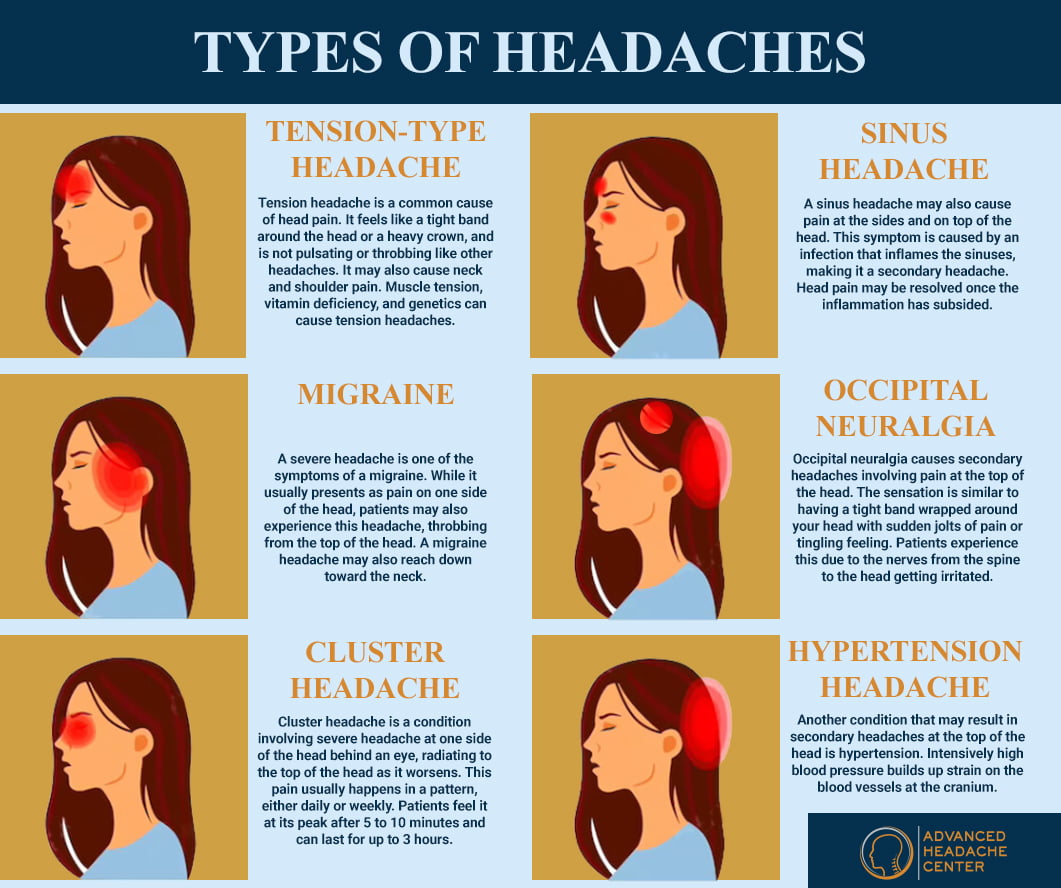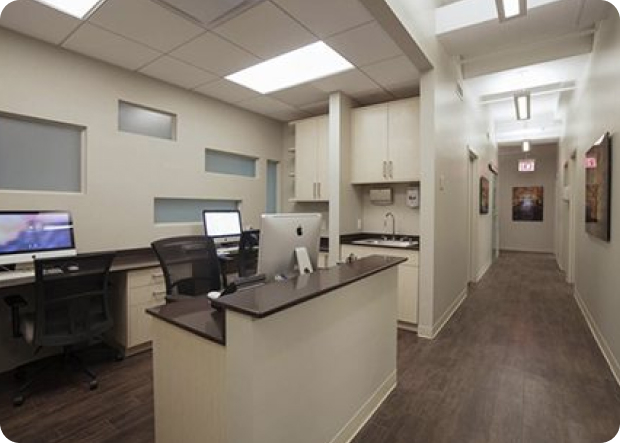A mild headache is a nuisance that may go away with over-the-counter pain relief medications, but severe headache pain might be a symptom of a more serious medical condition like a blood clot, tumor, or stroke. Knowing about the different types of headaches can help you know when you might need urgent care.
So what are the most common types of headaches that people should be aware of? Tension headaches, migraine headaches, cluster headaches, daily headaches, and sinus headaches are some of the most common types of headache disorders that millions of people suffer from. While some of them aren’t debilitating, they still should be checked by a doctor for proper diagnosis and treatment.
Knowing the Different Types of Headaches and Symptoms
Headaches refer to the mild to severe pain that patients feel on their heads or faces. People experience headache symptoms differently, but they’re often described as throbbing, constant, dull, or sharp. Aside from the type of headache pain that individuals may feel, headaches also vary in severity, frequency, and location.
According to the American Journal of Medicine, headaches are almost a universal experience that about 96% of people suffer from at some point in their lives. Although most cases of headache pain aren’t dangerous, some headaches are a sign of a more serious health condition that requires medical attention.

There are over a hundred different types of headache disorders, but here are some types that people should be aware of:
1) Tension Headache
Tension-type headache (also known as stress headache) is one of the most common forms of headache. According to the International Headache Society, this headache disorder affects around 30% to 78% of the population.
It often feels like a tightening band around the head, but some patients may also experience it along their stiff neck and shoulders. They may feel mild to moderate head pain, but it doesn’t get worse with specific movements or physical activities. Patients don’t feel nauseous when they have tension headaches but in rare cases, they may also experience increased sensitivity to light and sound.
The exact cause of tension headaches is still unknown, but they may be triggered by a lot of different things like stress, fatigue, poor posture, lack of sleep, and more. Depending on the frequency and duration of the symptom, tension headaches may be classified as infrequent episodic TTH, frequent episodic TTH, or chronic TTH.
2) Migraine Headache
Migraine headache is another type of primary headache disorder that affects millions of people worldwide. The recurring headache pain that migraine patients experience is usually more severe than tension-type headaches.
Migraine headaches feel like pounding or throbbing pain that lasts from 4 hours up to 3 days. It’s also accompanied by other symptoms like vomiting, nausea, light sensitivity, sound sensitivity, loss of appetite, and upset stomach.
Like tension-type headaches, it’s still unclear what the definitive cause of migraine is. However, many doctors and medical researchers believe that it’s due to abnormal brain activities that affect chemicals, blood vessels, and nerves. Frequent headaches caused by migraine may be triggered by bright lights, extreme weather, loud sounds, and more.
Migraines also affect more women than men because of their hormone fluctuations. According to a 2018 study, migraine headaches are observed in females during their menopause, menstrual cycle, hormone replacement therapy, pregnancy, and use of contraceptives.
3) Cluster Headache
Cluster headaches are a lot less common, but they’re severe enough that some patients can’t sit still during an attack. Anyone may have cluster headaches, but middle-aged men with a history of smoking are more at risk of this headache disorder than others.
This headache type got its name because the head pain usually comes in clusters – with 1 to 8 headache attacks in a day during a 1 to 3-month period every year. Cluster headaches usually occur around the same time every year or two.
Patients may feel a cluster headache on one side of their head. The pain they experience is so severe that many of them describe it as the worst headache of their life. The eye on the affected side becomes red and watery as the eyelid droops and the nose runs. The headache symptom is sudden and usually lasts for 30 to 60 minutes.
The exact cause of cluster headaches is also unknown, but it has something to do with the trigeminal nerve. This nerve is responsible for heat and pain sensations in the face, forehead, cheek, ear, and jaw.
4) Chronic Daily Headache
Chronic daily headache is a type of headache pain that patients may experience for at least 15 days per month for 3 months. Some episodes of chronic daily headaches are short, while others may last for more than 4 hours at a time. Your chronic headache may be one of the types of primary headache: chronic migraine, chronic tension headache, new daily persistent headache, or hemicrania continua.
To treat chronic daily headaches, patients need to consult with a healthcare provider first to determine the exact type of headache they have. It also helps to have a headache diary to record patterns of headaches. Taking an over-the-counter pain medication may help in some cases, but remember to only have them as recommended to avoid a rebound headache.
5) Sinus Headache
Sinus headaches cause deep and constant facial pain in the forehead, cheekbones, and along the bridge of the nose. They occur when the sinus cavities in the head become filled and inflamed, whether it’s because of sinusitis or allergic reactions. Aside from facial pain and pressure, patients also experience other sinus symptoms like fullness in the ears, swollen faces, fever, and a runny nose.
Sinus headaches are also often mistaken for a migraine flare up, but the main difference between them is the color and consistency of the nasal discharge – the discharge that comes with sinus headaches is yellow or green with thicker consistency compared to migraine headaches’ clear and thin mucus.
A sinus headache can be a chronic or acute headache, depending on how often the patient experiences them.
6) Other Headache Types
In addition to the previous headache types, here are other kinds that some patients may experience:
- Medication overuse headache: Also known as rebound headache, this kind of headache disorder is caused by long-term and excessive use of pain medicine to treat headaches. It usually occurs along with chronic migraines and tension headaches.
- Thunderclap headache: This rare type of headache appears out of nowhere and peaks immediately. It may be caused by a head injury, blood vessel rupture, stroke, sudden blood pressure changes, inflamed blood vessels, and other issues in the blood vessels near the brain.
- Spinal headache: This refers to the headache pain that patients feel after getting an epidural or spinal block injection. It’s usually caused by a spinal fluid leak that reaches the lumbar puncture site.
What are the Main Causes of Headaches?
Headaches may affect any part of the head and even extend to the neck and shoulders in some cases. The pain patients feel is usually caused by the mix of signals between the brain, nerves, and blood vessels. While the exact cause and mechanism of headaches are still difficult to determine, classifying the patient’s pain is still an essential step to finding the right treatment.
1) Primary vs. Secondary Causes
Doctors may categorize a patient’s headache condition based on whether there’s an underlying health condition that causes the pain. According to the International Headache Society, headache pain may be primary or secondary.
Primary headaches aren’t symptoms of underlying medical conditions. Patients feel headache pain because of problems or overactivity of certain structures in the head, like the brain, muscles, nerves, hormones, and blood vessels.
On the other hand, a secondary headache is a symptom of another health condition. Patients may feel headache pain because of pregnancy, systemic conditions, infections, stroke, brain tumors, and more.
2) Most Common Reasons for Headaches
- Underlying health conditions: This includes fevers, colds, or infections. In some cases, patients may also experience acute or chronic headaches because of serious medical problems or neurological disorders.
- Poor stress management: Depression and emotional stress are among the top causes of headaches for many people. Poor lifestyle choices like skipping meals and irregular sleeping patterns may also result in headaches.
- Medical records and genetics: Some types of headaches like migraine headaches may be inherited. When a parent has a history of migraines, then their children are more likely to experience migraine headaches than others.
Should I Consult a Doctor if I Have a Severe Headache?
A mild headache doesn’t usually require a visit to a headache doctor since they only cause minor inconveniences. They’re also easily solved by taking a pain reliever, but it’s best to consult a doctor immediately if the headache pain worsens or persists.
When you experience severe or unusual headaches, make sure to talk to a medical professional immediately and describe the symptoms accurately. They may conduct physical exams or imaging tests to determine the cause or rule out possibilities. For more serious headache symptoms, the doctor may refer you to a headache specialist.
The Best Severe Headache Treatment for You at Advanced Headache Center
The treatment of headaches only starts after getting the right diagnosis for the condition. At Advanced Headache Center, we may recommend either one or more of the following treatment options:
1) Multimodal Approach
This treatment approach integrates both pharmacological and non-pharmacological options to help patients recover from headache pain more quickly. With the pharmacological approach, our doctors assist patients with the right pain relief medication to alleviate their symptoms and avoid the unwanted side effects of some medicines. We may also recommend other treatments like blocks, infusions, and injections for preventive measures.
2) Headache Medications
Headache medications come in many different types that help alleviate headache pain or prevent it from happening. In some cases, we may prescribe taking multiple migraine or headache medications to achieve the best results.
3) Alternative Medicine
Alternative medicine is the best option for patients who want to avoid medications as much as possible.
Depending on the cause of the headache, we may perform the following treatment options for you:
- Physical therapy may involve relaxation routines, strengthening exercises, and more.
- Chiropractic care refers to the manual adjustment of the spine to relieve pain and improve spinal function.
- Acupuncture is the traditional Chinese relaxation technique that uses hair-thin needles to stimulate the nervous system and alleviate pain.
4) Infusions and Injections
When oral medications don’t seem to be effective, our headache specialists may recommend directly administering the medication into the nerve blocks or the bloodstream.
Here are some of the injections and infusions we offer at Advanced Headache Center:
- Trigger point injections
- Occipital nerve block injections
- Sphenopalatine ganglion block
- Intravenous infusions
Integrative Headache Treatments at Advanced Headache Center
Headaches and their accompanying symptoms can greatly affect your quality of life – from disrupting your sleep to preventing you from completing daily tasks comfortably. If your headache seems severe and unusual, make sure to consult a healthcare provider immediately for proper diagnosis and treatment.
Advanced Headache Center is the trusted center for integrative headache treatments. Our approaches are uniquely designed based on each patient’s needs and conditions for better and long-lasting pain relief results. Get your life back on track today by calling us to book an appointment.




